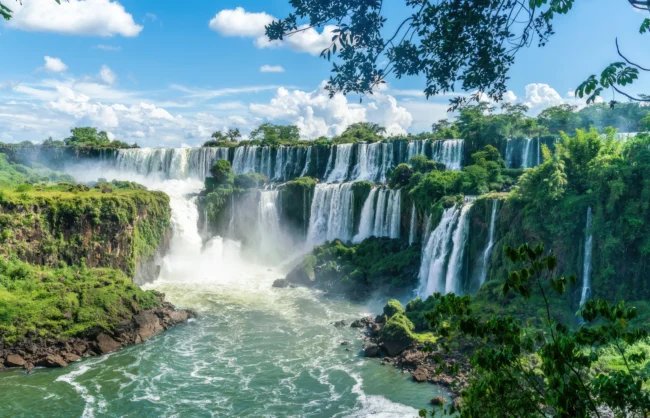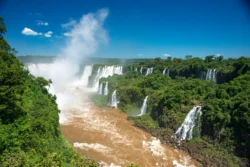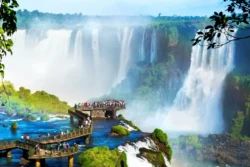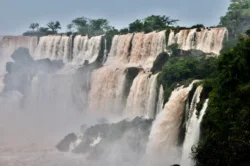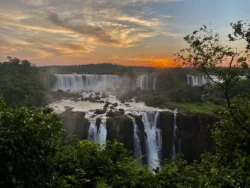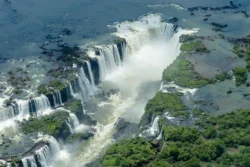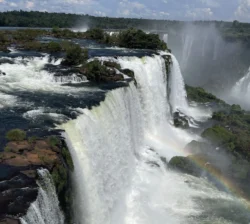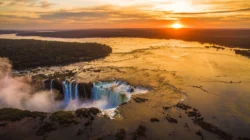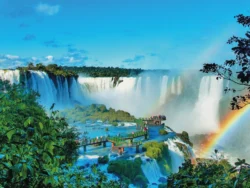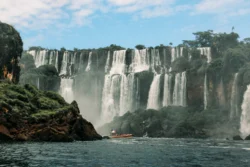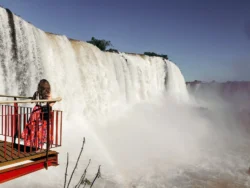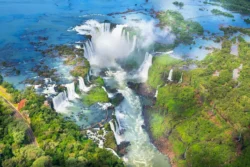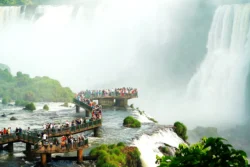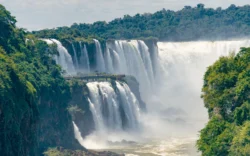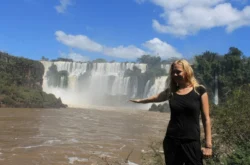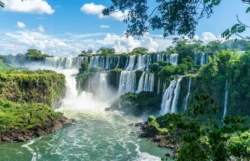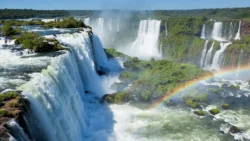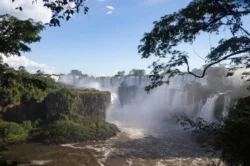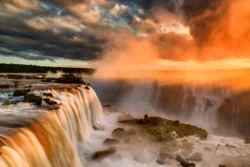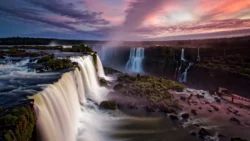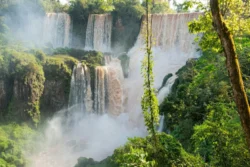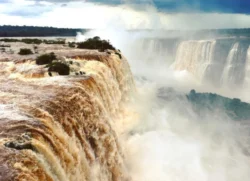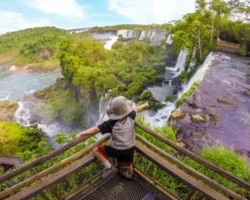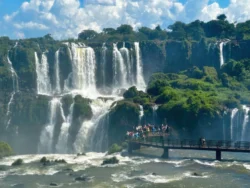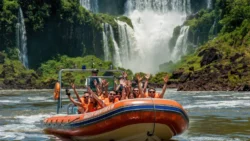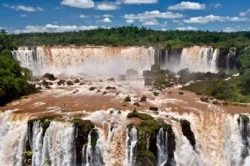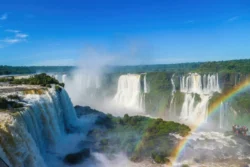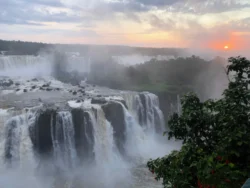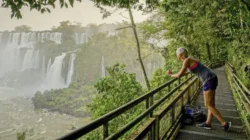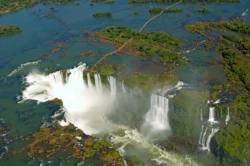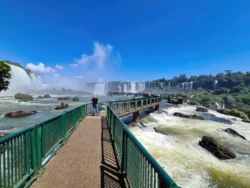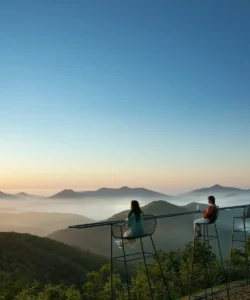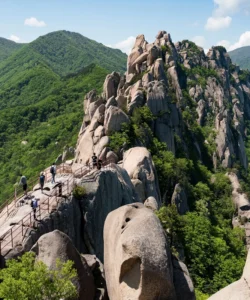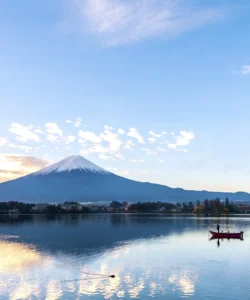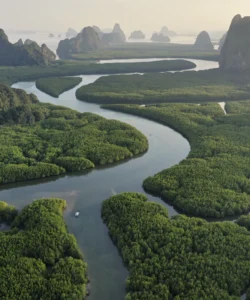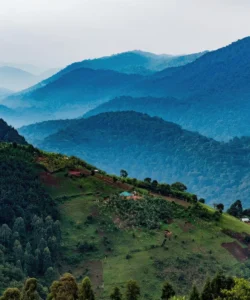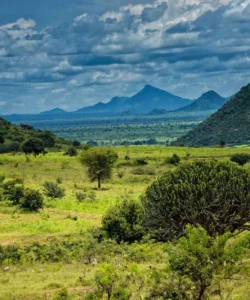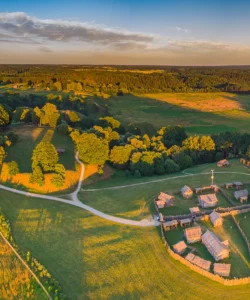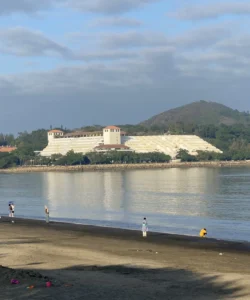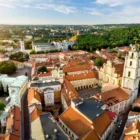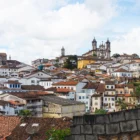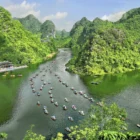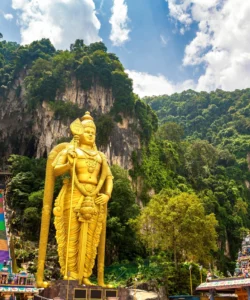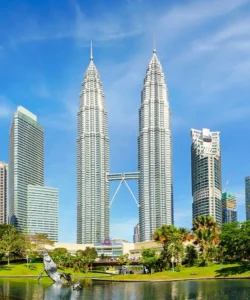Iguazu Falls: Earth’s Most Expansive and Thunderous Water Spectacle
Iguazu Falls (Spanish: Cataratas del Iguazú; Portuguese: Cataratas do Iguaçu) is a colossal waterfall system located on the border of Argentina (Misiones Province) and Brazil (Paraná State), with a close proximity to Paraguay. Formed by ancient volcanic activity, these falls are renowned as the largest waterfall system in the world, creating a thunderous symphony of crashing water, a permanent mist, and spectacular rainbows that envelop the surrounding subtropical rainforest. A UNESCO World Heritage site on both the Argentine and Brazilian sides, Iguazu Falls is an awe-inspiring natural wonder, offering both panoramic vistas and intimate encounters with nature’s immense power.
Name: Iguazu Falls (Cataratas del Iguazú in Argentina, Cataratas do Iguaçu in Brazil). The name “Iguazu” comes from the indigenous Tupi-Guarani language, meaning “great water.”
Address:
- Argentina Side: Parque Nacional Iguazú, Puerto Iguazú, Misiones Province, Argentina.
- Brazil Side: Parque Nacional do Iguaçu, Foz do Iguaçu, Paraná State, Brazil.
How to get there:
Reaching Iguazu Falls, involves a very long international journey to South America, followed by travel to one of the gateway cities:
- From Buenos Aires (Argentina) or São Paulo (Brazil) to Iguazu Falls:
- Fly to Puerto Iguazú Airport (IGR, Argentina) or Foz do Iguaçu International Airport (IGU, Brazil): Both airports are well-served by domestic flights from their respective capital cities. This is the fastest and most convenient way to reach the falls. Flights typically take around 2 hours.
- From the Airports to the Parks: Taxis, ride-sharing services (Uber/Grab may be available in Foz do Iguaçu), or airport shuttles are readily available to take you to your accommodation in Puerto Iguazú (Argentina) or Foz do Iguaçu (Brazil), and then to the national park entrances.
- Crossing the Border: To experience both sides of the falls (highly recommended!), you will need to cross the international border between Argentina and Brazil. Taxis, public buses, or tour operators can facilitate this. Note that visa requirements might apply depending on your nationality.
Best Time to Visit:
Iguazu Falls can be visited year-round, as temperatures are generally pleasant in this subtropical region. However, consider these factors:
- Wet Season (December to February/March): The river flow is at its highest, making the falls incredibly powerful and visually grand. However, there’s a higher chance of rain, humidity, and more mist, which can sometimes obscure views.
- Dryer Season (April to November): Less rain, clearer skies, and pleasant temperatures. Water levels are still substantial, but can vary. Animal sightings may be slightly more frequent as they gather at water sources.
Landscape and Architecture:
Iguazu Falls’ “architecture” is a magnificent display of natural geological forces, shaped over millions of years, integrated with thoughtful human infrastructure to enhance viewing:
- Vast System of Cascades: Iguazu is not a single waterfall but a massive semi-circular system stretching nearly 3 kilometers (1.7 miles) wide, comprising between 150 and 300 individual waterfalls and cataracts, depending on the water level. The falls drop vertically from 60 to 82 meters (197 to 269 feet).
- Devil’s Throat (Garganta del Diablo / Garganta do Diabo): The most iconic and powerful section. This gigantic, U-shaped chasm, 80 meters high and 150 meters wide, funnels about half of the river’s flow into a thunderous abyss, creating a permanent cloud of mist and rainbows. It is best viewed from walkways that extend directly over the falls on the Argentine side, and from a panoramic viewpoint on the Brazilian side.
- Basaltic Formations: The falls plunge over the edge of the Paraná Plateau, formed by columnar basalt rock sequences that are part of a 1,000-meter-thick geological formation. The staircase-like drops are a result of these basalt layers.
- Subtropical Rainforest: The falls are set within a lush, dense subtropical rainforest (part of the Upper Paraná Atlantic Forest biome), which is incredibly biodiverse, with over 2,000 species of vascular plants, vibrant butterflies, and a rich array of wildlife (including tapirs, giant anteaters, howler monkeys, ocelots, jaguars, and caimans). The constant spray from the falls creates a unique, highly humid microclimate within the forest.
- Extensive Walkways and Trails: Both the Argentine and Brazilian national parks feature extensive networks of elevated walkways, trails, and viewing platforms that bring visitors incredibly close to, and even directly over, the various cascades.
- Argentine Side: Offers a more extensive and intimate experience with multiple circuits (Upper, Lower, Devil’s Throat) that allow visitors to walk on top of and among the falls, and get drenched by the mist. An ecological train (Rainforest Ecological Train) transports visitors to various trailheads.
- Brazilian Side: Provides more panoramic, wide-angle views of the entire falls system from a single, impactful pathway. A panoramic elevator further enhances views.
- Islands: Numerous islands along the 2.7-kilometer edge divide the falls into separate cataracts, contributing to its fragmented yet expansive appearance.
- Boat Tours: Adventure boat tours take visitors directly into the misty spray and powerful currents at the base of several falls, offering a truly immersive experience.
What makes it famous:
Iguazu Falls is famous for:
- World’s Largest Waterfall System: Its sheer width (nearly 3 km) and the multitude of its individual cascades make it the most expansive waterfall system on Earth, creating an overwhelming sense of scale.
- Devil’s Throat (Garganta del Diablo): This iconic, U-shaped cataract is the most powerful section of the falls, known for its immense roar, towering spray, and incredible visual impact.
- UNESCO World Heritage Site: Both Iguazú National Park (Argentina) and Iguaçu National Park (Brazil) are inscribed as UNESCO World Heritage sites, recognizing their outstanding natural beauty and exceptional biodiversity.
- Natural Wonder Status: It was voted one of the “New7Wonders of Nature” in 2011.
- Panoramic vs. Intimate Views: The ability to experience the falls from two different countries, offering contrasting yet equally spectacular perspectives – panoramic vistas from Brazil and immersive, up-close encounters from Argentina – is a major draw.
- Eleanor Roosevelt’s Quote: Famously, upon seeing Iguazu Falls, Eleanor Roosevelt reportedly exclaimed, “Poor Niagara!”, highlighting its superior grandeur compared to Niagara Falls.
- Rich Biodiversity: The surrounding Atlantic Forest is a highly biodiverse ecosystem, home to unique flora and fauna, making it a nature lover’s paradise beyond just the falls.
- Powerful Sensory Experience: The thundering roar of the water, the constant mist, and the vibrant rainbows create an incredibly immersive and powerful sensory experience.
Differences from some other wonders:
Iguazu Falls distinguishes itself from other famous waterfalls and natural wonders in several key ways:
- Multitude of Cascades vs. Single Curtain: While Victoria Falls (Africa) boasts the largest single curtain of falling water, Iguazu’s defining characteristic is its system of hundreds of individual cascades separated by islands, creating an incredibly vast and intricate series of drops. This fragmented yet expansive layout is unique.
- Dual-Country Perspective: The opportunity to experience the falls from two distinct countries (Argentina and Brazil), each offering complementary and unique viewing angles (panoramic from Brazil, intimate/immersive from Argentina), is a significant differentiator. This allows for a comprehensive appreciation of its vastness and power.
- Walkways Over the Falls: The extensive network of walkways that extend directly over the falls (especially on the Argentine side) allows visitors to stand literally above the plunging water, providing a unique and thrilling perspective that is not common at many other major waterfalls.
- Subtropical Rainforest Setting: Unlike Niagara Falls, which is heavily urbanized, Iguazu is set within a vibrant, biodiverse subtropical rainforest, enhancing its natural beauty and providing a lush backdrop for the thunderous water.
- U-Shaped “Devil’s Throat”: The unique U-shaped chasm of the Devil’s Throat, which funnels a massive volume of water, creates a particularly intense and iconic visual and auditory experience not replicated elsewhere.
- Volcanic Origin: Its geological formation due to ancient basaltic lava flows is a key aspect of its history, shaping its unique stepped character.
In essence, Iguazu Falls is an unparalleled natural wonder, a majestic and thunderous symphony of water and rock, offering an immersive, multi-faceted experience across two countries, and standing as a powerful testament to the breathtaking grandeur of the natural world.
